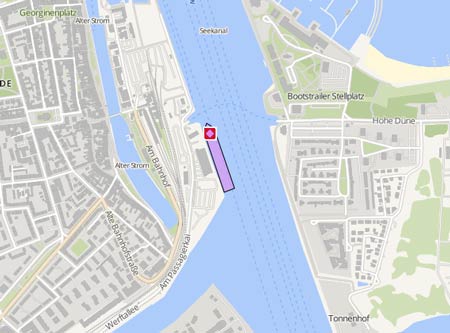ANGELES ALVARINO
Kurs/Position
Die letzten Häfen
Die letzten Wegpunkte
Die neuesten Nachrichten
Research ship recovered lost anchor and pipeline connection
The ‘Ángeles Alvariño’ assisted a tanker that supplies water to banana plantations in the area of Puerto Naos (La Palma) . The anchoring and connection of the submarine pipeline of the tanker was lost in a maneuver, and the help of the Spanish Institute of Oceanography was requested to locate it and support in the recovery on Oct 21, 2021. The company in charge of the installation of the water supply system requested, through the General Water Directorate of the Ministry for the Ecological Transition and the Demographic Challenge (MITERD), the urgent intervention of the Oceanographic Institute to locate the anchor and connection of the submarine pipeline. The ROV 'Liropus' visually inspected the area up to a depth of 240 meters. After six hours of tracking, it was concluded that the anchorage could destabilize and fall through a small underwater canyon and reach another area. For this reason, the IEO marine geology team on board the 'Ángeles Alvariño' chose to carry out a very high-resolution bathymetry with which to try to locate the anchor or at least narrow down the possible search areas. Once the data were processed, three possible points where the anchor could be found were defined. based on the mapped morphologies, the acoustic impedance and the possible trajectories that the structure would have followed according to the slope. In the first of the sampled points, the structure was located and its recovery was carried out, a complex operation to tie up the anchor, located more than 130 meters deep, with the ROV. After two days of operation, the scientific team resumed its work in front of the lava delta for the physical-chemical and biological characterization of the water column and the daily mapping of the advance of the lava carried out by the Spanish Institute of Oceanography in the framework of the Vulcana project (Canarian Submarine Volcanology). The 'Ángeles Alvariño' had arrived in La Palma on Oc 17 to continue the work carried out in a previous campaign by the "Ramón Margalef" in the framework of the volcanic eruption on La Palma. A team of oceanographers, geologists and microbiologists was studying how the marine ecosystem can be affected by the intrusion of lava into the ocean, both in the benthic habitat (the one linked to the bottom), and in the pelagic (linked to the water column).
Search for child and his father coming to its end
The head of the Court of Violence against Women of Santa Cruz de Tenerife will allow the cease of the search for Tomás and Anna Gimeno by the 'Ángeles Alvariño' in the coming days, concluding that it is impossible to continue with these tasks, due to the steepness of the underwater terrain that is being tracked. The ship's operations manager describe the area where new results could be found as "completely unapproachable" for the exploration. Given the underwater currents it cannot be guaranteed that a body weighed down with a diving belt would not roll away and could reach an undetermined place and, therefore, outside the search capacity available. Before, an unmanned robot located and recovered the body of one of Tomás Gimeno's daughters, Olivia, inside a weighted sports bag. Next to that bag there was another one with similar characteristics in which the father supposedly dumped the body of the youngest of his daughters, Anna, but it was cracked and empty. After that discovery, on June 10 the 'Ángeles Alvariño' found two oxygen bottles in a more remote area, where investigators suspect that Tomás Gimeno threw himself into the sea to commit suicide. As the Civil Guard was able to verify in the framework of its investigations, during the long drift of the boat of the alleged filicide after the loss of his mobile signal, for a short period of time the engines started working again and Gimeno navigated for about three minutes. The report sent to the judge detailed that the point where the engines stopped again became the most likely point where Tomás could have thrown himself into the sea, and it is from this point that a new search area was set in 500 meters depth. In that area, the Liropus 2000 underwater robot made 176 lines and transits with a total distance traveled of 60,006 meters and an explored area of 611,903 square meters, which was later expanded on both sides. Then the discovery of two diving 'bottles' that belonged to Tomás Gimeno took place, a type of bottle that gives a very limited air supply. Investigators speculate that the father used them in his suicide attempt to ensure he reached the necessary depth to avoid turning back. Search patterns were established five meters apart from each other around the area where these two bottles were found in order to be sure that no objects were left in the area, no matter how small. The researchers also looked for the lead belt that Tomás Gimeno may have used to ballast himself, which would confirm that he was adrift, but it could not be found.
Search to be continued unti ROV breaks down
The 'Ángeles Alvariño' plans to continue searching for Anna and Tomás until the underwater robot with which it is equipped breaks down definitively. The ROV has already exceeded its estimated working time and needs to return to the base in Vigo (Galicia) for maintenence, which would take several weeks of interruption in the search. As for the underwater robot offered by the Tenerife Council, it is confirmed that it is not qualified for the task.
News schreiben

